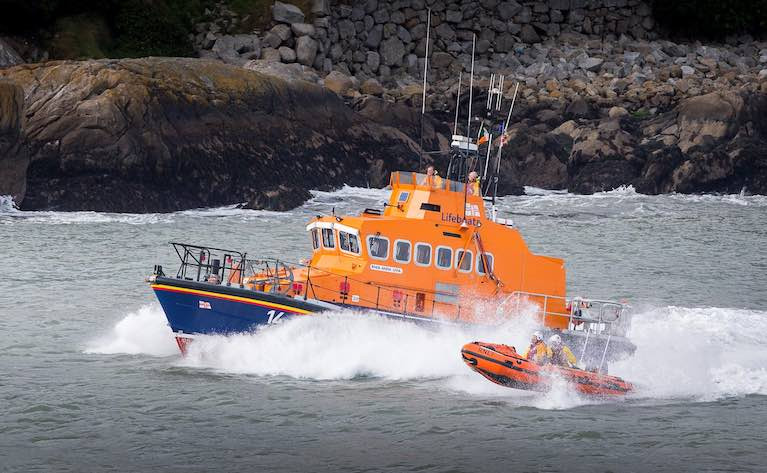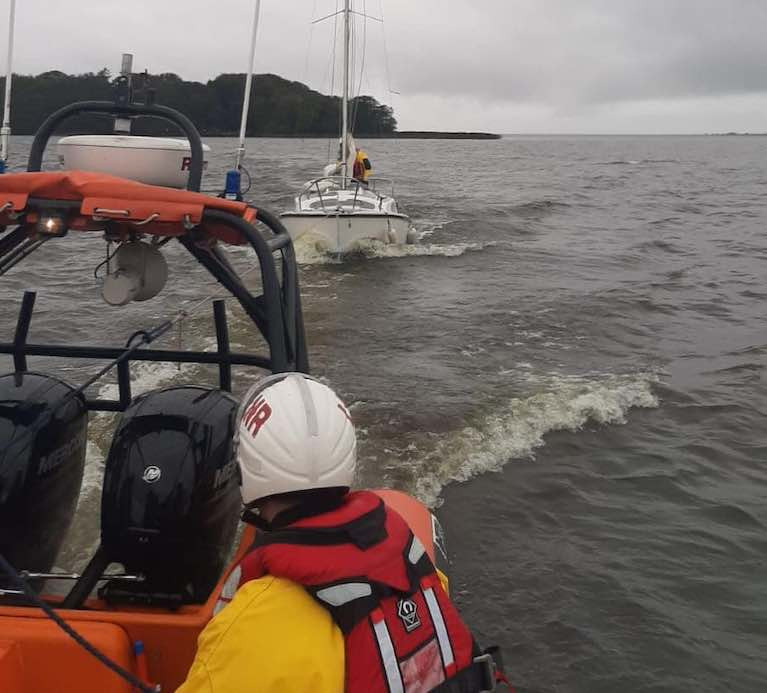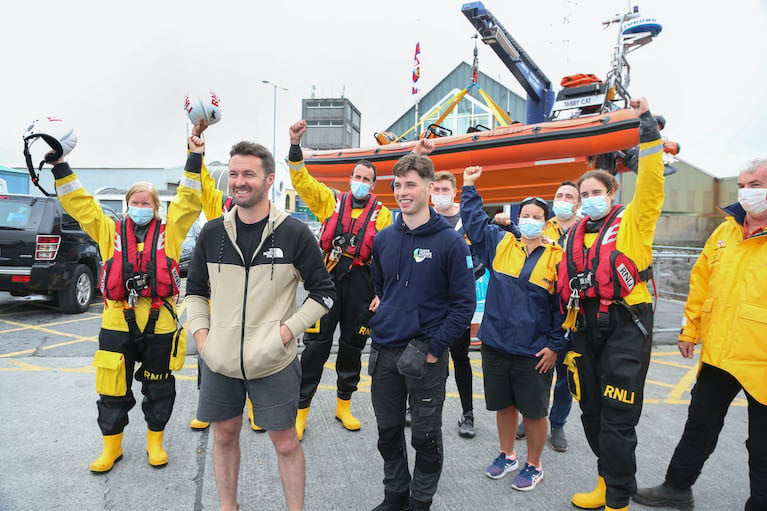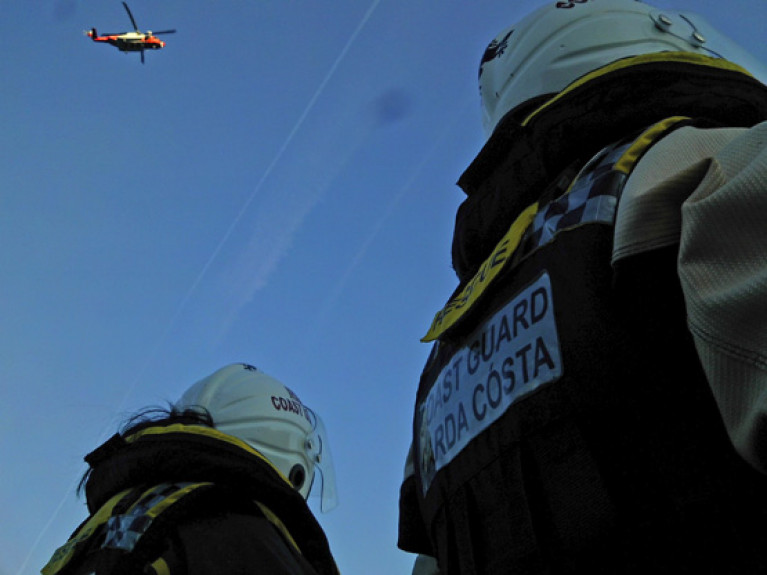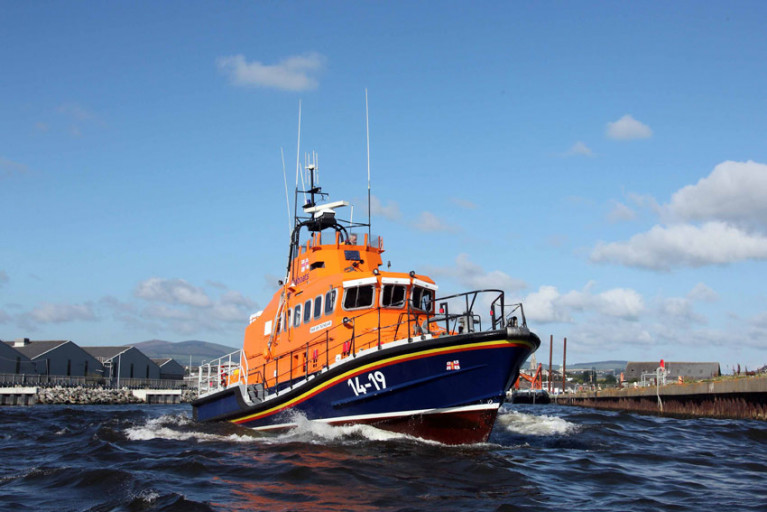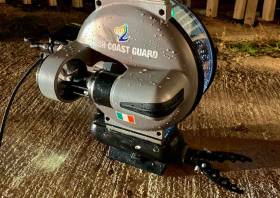Displaying items by tag: Rescue
Why Irish Tow Surf Rescue Club Opposes County Clare Jet Ski Ban
“Aquabikes” caught the attention of former Irish Times journalist Kevin Myers back in 1982.
The Irishman’s Diary writer was seriously concerned about the pressure windsurfers were putting on the RNLI Dun Laoghaire lifeboat at the time.
He had read about these “aquabikes”, made by a Japanese motorbike company, which “skid across the water, steered by handlebars”.
Although there might be “cacophonous” drawbacks, this vehicle might prove useful in rescuing windsurfers, he wrote - if it wasn’t engaged in knocking them down, or worse...
Almost 40 years later, and jetskis have proved their worth in rescue, with trained riders able to access areas of the coastline that may prove too dangerous for coast and cliff rescue crews, lifeboats or helicopters.
However, jetskis still get bad press among those who don’t understand their benefits – or those who have witnessed untrained and ill-considerate use of them. Now Clare County Council wants to ban their use altogether on a number of beaches.
 The Irish Tow Surf Rescue Club has objected to a proposed jetski ban Photo: ITSRC via Facebook
The Irish Tow Surf Rescue Club has objected to a proposed jetski ban Photo: ITSRC via Facebook
Clare fireman, lifeguard and surfer Peter Conroy owes his life to a jetski rescue. He was one of the founders of the Irish Tow Surf Rescue Club which has provided training, and invaluable support to surfers, and to open water sea swimmers.
Organisers of marine events have benefited from their voluntary assistance, and the club has also provided defibrillators at a number of coastal locations.
Conroy spoke to Wavelengths this week about his rescue, and about why his club opposes the proposed ban.
Listen to Wavelengths below
And you can then view a bit more of the work of the Irish Tow Surf Rescue Club here
Lough Neagh Rescue was called last Friday evening to a 24ft cruiser that had lost power.
The vessel was located about 1.5 nautical miles to the east of Ballyronan on the west side of Lough Neagh.
Lifeboats were launched and located the vessel with two people on both of whom were safe and well. A towline was secured, and the vessel towed into Ballyronan Marina, where it was safely moored to the jetty.
The lifeboats returned to base, were cleaned, refuelled and are ready for the next tasking.
Lough Neagh Rescue is a Limited Company and a registered Charity. It is made up of 60 highly trained volunteers, four lifeboats, two vans and an off-road jeep, operating on the largest lake by area in the British Isles with a surface area of 151 square miles.
Rescue agencies are reporting a record year for incidents on the water as thousands of people turned to the coastline, lakes and rivers during Covid-19.
The Irish Coast Guard, RNLI and Water Safety Ireland have all been under pressure to comply with Covid-19 protective measures and to cope with the large number of emergency alerts.
A total of 500 people were rescued by lifeguards this season, compared to 260 last year.
The last time figures were this high was in 2013, when there were 430 rescues.
There were also no confirmed cases of lifeguards testing positive for the Covid-19.
Water Safety Ireland (WSI) has recorded the lowest number of accidental drownings, at 37 to date, compared to 62 accidental drownings in 2019.
The RNLI said its lifeboat crews have been “exceptionally busy”, with 730 call outs to date this year compared to just over 1,000 launches in the Republic last year.
Dun Laoghaire RNLI is busiest
The busiest station has been at Dun Laoghaire Harbour, Co Dublin, with nearly 100 call outs for this year so far, according to RNLI Lifesaving Lead for Ireland Owen Medland.
Both organisations had to put special Covid 19 avoidance measures in place for volunteers and lifeguards employed by local authorities.
Independent TD Catherine Connolly is calling for publication of an Irish Coast Guard analysis of one of the most high profile rescues – that of paddleboarders Sara Feeney (23) and Ellen Glynn (17) in Galway Bay on August 13th last.
Ms Connolly is among those who have paid tribute to Claddagh fisherman Patrick Oliver and his son Morgan for their rescue of Ms Feeney and Ms Glynn after 15 hours at sea. She said, however, that "lessons needed to be learned" about the search pattern in the inner bay, rather than out towards the Aran islands, and co-ordination of volunteers onshore.
In a Dáil reply to a question tabled by Ms Connolly, Minister for Transport Eamon Ryan said the initial search was focused along the northern shore to ascertain if they were attempting to get ashore or had got ashore.
He said the RNLI Galway lifeboat was tasked within three minutes of the initial report at 10.05 pm and the RNLI Aran lifeboat was tasked at 11.19 pm.
He said the Shannon based Coast Guard helicopter was tasked to the scene at 11.02 pm and was recorded as proceeding at 11.25 pm.
Mr Ryan said the search was moving to the south-west of Galway Bay and the Aran Islands, with aerial surface and coastal searches off the islands on the morning of their rescue, and a member of the public alerted Valentia Coast Guard to a possible sighting after 11 am on August 13th, he said.
Visibility had been very poor in the early part of the day with fog at sea till mid-morning.
Fixed Wing & Drones May be Part of New Air/Sea Search & Rescue Contract But no Apparent Role for Air Corps
The Irish Coast Guard has asked the Government to include fixed-wing aircraft and use of drones in the new State contract for search and rescue.
As The Sunday Times reports today, tender offers for the new air/sea service, which will replace the existing €60 million a year contract, may be asked to suggest how a mixture of helicopters, fixed-wing and drones could be used – without necessarily being tied to four helicopter bases.
CHC Ireland, which operates a fleet of Sikorsky S-92 helicopters from bases at Shannon, Sligo, Dublin and Waterford for the Irish Coast Guard at a cost of €60 million annually, has been given a one-year extension to its ten-year contract to 2023.
A recent industry briefing in advance of the publication of a tender for the new service from 2024 specified that bidders should be able to deploy a helicopter to anywhere in Ireland or within 12 nautical miles of the coast in 45 minutes of being airborne and be capable of search and rescue in the Irish exclusive economic zone.
It also specified providing one Coast Guard search and surveillance aircraft - which could be fixed wing or drones - on 24-hour standby.
This would reduce the flying time and fuel expenditure of search and rescue helicopters
Questions are being asked within military circles about the need – and possible extra expense of – a dedicated fixed-wing aircraft under the control of the Irish Coast Guard, which could push the contract price up considerably.
The Air Corps is due to take delivery of two new Casa maritime patrol aircraft at a cost of €235 million.
Earlier this month, however, Minister for Foreign Affairs and Defence Simon Coveney ruled out a role for the Air Corps in search and rescue.
The Air Corps pioneered helicopter rescue off this coast 40 years ago, with long-range missions undertaken by the British RAF and Royal Navy, but it was withdrawn from search and rescue in 2003 by then defence minister Michael Smith.
The Air Corps currently flies the emergency aeromedical service (EAS), based in Athlone, Co Westmeath, which recently marked a milestone by airlifting its 3000th patient.
The Irish Coast Guard flew 54 medical missions this year, with an additional two paediatric transfers to Britain. It also serves the islands and flew 91 medical evacuations from offshore communities.
Read more in The Sunday Times here
Last Sunday (4th October) Lough Neagh Rescue Lifeboat was tasked to two people stranded on Coney Island as their vessel had mechanical issues. Coney Island is owned by the National Trust and lies in the south-west corner of Lough Neagh about 1km from Maghery, a village on the Co Armagh shore.
Due to the adverse weather conditions, it was decided to take the persons off the island and bring them to Maghery. With the two people safely ashore and handed into the care of the Lough Neagh Coastguard team it was decided that the vessel could be brought to Maghery also, so the crew went back to the island, rigged a tow and brought the casualty vessel safely to the shore in Maghery.
Lough Neagh Rescue is a charitable 24-hour voluntary search and rescue service operating from three stations on the Lough - one at Ardboe in County Tyrone, one at Antrim in the North and the other from Kinnego Marina in the south near Lurgan, County Armagh.
Lough Neagh is the largest lake in the British Isles being about 32 km long and 14 km wide. It is mostly shallow with an average depth of 9 m. It is very exposed and in windy conditions can become extremely rough very quickly. It is used extensively by a wide variety of recreation and commercial craft with two sailing clubs, one at either end – Antrim Boat Club in the north and Lough Neagh Sailing Club at Kinnego in the south.
Galway Fishermen Receive Mayoral Tribute for Paddleboarder Rescue
The two Galway fishermen who rescued two paddleboarders in August have been honoured at a mayoral reception.
Mayor of Galway Mike Cubbard described Patrick Oliver and his son Morgan as “Claddagh royalty” when he presented them with a framed presentation scroll and a bronze model of a traditional Irish currach.
The presentation at a tightly controlled event in Salthill’s Leisureland was in honour of their achievements in saving the lives of Galway cousins Sara Feeney and Ellen Glynn in August.
Mr Cubbard said that "the rescue highlights the fantastic community spirit which exists in Galway as hundreds of people across the city and county offered their help with the search operation".
The cousins who were also recognised for their bravery survived 15 hours at sea after they were swept some 17 nautical miles across the bay and towards the Atlantic in mid August.
The fishermen have already been awarded the Afloat.ie National Seamanship Trophy for their efforts.
The Olivers recorded another rescue when they pulled a man from the river Corrib last month.
Major Search Operation For Sea Angler Missing Off Kerry Coast
Independent.ie reports that a major search and rescue operation was launched last night (Wednesday 26 August) for a sea angler on the Kerry coast.
The man reportedly fell into the water while fishing at Kerry Head.
His angling partner entered the water after him to attempt a rescue, but got into difficulty and was recovered shortly after.
Elsewhere, the body of a fisherman who went missing from his boat of Teelin in Co Donegal just hours before was found late last night.
And a young man has spoken of his role in a ‘terrifying’ rescue of a 10-year-0d boy in difficulty in the water off Com Dhíneol in West Kerry yesterday afternoon.
Twenty-two-year-old Mícheál Keogh sprang into action with another man, Dan Sullivan, to assist the boy’s two uncles in retrieving the youngster amid the strong current.
“It’s a very dangerous place to swim,” Keogh told RTÉ Radio 1’s Morning Ireland. “None of them could swim so it was mad altogether but we were able to get them out.”
TheJournal.ie has more on the story HERE.
Coastal Walking Safety Reminder After Two Washed 15ft Off Arklow Pier By Large Wave
Volunteers from Arklow RNLI were called to the scene where two people were injured after a wave swept them from the upper deck of a pier in the Co Wicklow town yesterday (Sunday 22 December).
As TheJournal.ie reports, it’s understood that a large wave crashed against the harbour wall and washed two people from the top of the pier 15 feet to the lower deck.
Neither individual was washed into the sea but both were hospitalised for treatment. Community safety officer Mark Corcoran reminded the public to ‘stay back, stay high and stay dry’ when walking near the coast.
The incident came just hours after the lifeboat charity and the Irish Coast Guard issued their annual safety message for the Christmas and New Year period.
Galway Coroner Pays tribute to French Canadian Camper & Emergency Services who Tried to Assist Swiss Woman Fatally Injured by Caravan in Storm Ali
A Galway coroner has paid tribute to a French-Canadian who tried to save the life of a Swiss woman when the caravan she was staying in at a Connemara campsite was swept into the sea during Storm Ali writes Lorna Siggins
Galway West coroner Dr Ciaran McLoughlin also paid tribute to the Irish Coast Guard, National Ambulance Service and Garda and to fellow doctor John Casey, who all risked their lives when attending the scene.
As Afloat reported previously, Swiss nurse Elvira Ferrari (58), a mother of three from Steinmaur, Zurich in Switzerland, tried to escape when winds flipped over the caravan and it was swept down a nine-metre (30 foot) drop into the sea on the morning of September 19th, 2018.
The storm-force 11 winds which hit the west coast were far stronger than speeds forecast, the inquest before Dr McLoughlin heard on Thursday (Oct 31).
The jury heard that Ms Ferrari had booked into the Clifden Eco Beach Camping and Caravan Park on September 16th, 2018, for three nights, and been offered the use of a mobile home as an alternative the previous night due to a bad forecast.
Ms Ferrari (58) had come to Ireland in August of that year to study English in Galway for three weeks and had planned to spend four days in Connemara.
The inquest heard that she had rented a bike in Clifden, which she was due to return on the day of the incident.
Witness Ms Sally Forth of Darlington, England, who was camping at the site, said that she saw a caravan blow over onto its side at about 7.45 am that morning, and it rolled onto a cliff edge and onto the beach. She saw the door open, and a figure trying to get out.
Mr Caleb-Amie Soltendieck, a French-Canadian who was staying at the eco-park with his girlfriend Shamie Gizuere Levesque, said he was alerted by Shamie who had seen the caravan blow over.
He ran out and spotted the caravan on the beach some nine metres (30 foot )below, and in the water.
Mr Soltendieck said he could see someone was trapped underneath.
He managed to get Ms Ferrari out from underneath, but she had severe injuries as her head had been crushed.
The eco-camp owner Kris Acton, who has run the caravan and campsite with his wife Tatjana since 2010, said the weather forecast for Wednesday, September 19th, 2018, had been for 70 mile per hour (MPH) winds.
He said an orange alert had been issued for that part of the coast.
Mr Acton had also checked a British weather forecast, which predicted 68 to 70 MPH winds.
Mr Acton said he had advised customers the night before to move, and had provided storm shields, and also advised those staying there with cars to use them as windbreaks.
He said his wife had spoken to Ms Ferrari on the Tuesday night and offered her the use of a mobile home, as the caravan would be very noisy in high winds.
At 7.45 am on the Wednesday morning, there was a knock on the door and a woman was shouting that a caravan had toppled over.
He ran down to the beach, saw a body, and was told by Mr Soltendieck that there was no pulse. The emergency services were called, and both he and his wife administered cardio-pulmonary resuscitation on instruction.
Mr Acton said that he believed the gusts were over 90 miles per hour and were of a “red alert” category, and winds of this ferocity would only occur in wintertime.
Ms Tatjana Acton said she had spoken to Ms Ferrari the night before, as there had been an issue with her credit card, and they spoke German to each other.
She said she had suggested Ms Ferrari transfer to a mobile home that night, but the Swiss guest seemed more concerned about an issue with her credit card.
Irish Coast Guard Cleggan officer Michael Murray, who reached the scene at 7.58 am, told Dr McLoughlin that the forecast was “well off” in his opinion, and was “near hurricane-force”. He said he had to move his jeep during the incident at one point as the winds were so severe.
Clifden GP Dr John Casey said in his statement that Ms Ferrari sustained catastrophic head injuries and he pronounced her dead at 8.17 am.
Garda Shane Nally of Clifden Garda station said he arrived with three colleagues, and ambulance staff, and Dr Casey was attending Ms Ferrari’s body, which was about three metres (10 ft) from the caravan on the beach.
Pathologist Dr Ramadan Shatwan gave the cause of death as a severe traumatic head injury.
Coroner Dr Ciaran McLoughlin paid tribute to Mr Soltendieck for trying to save Ms Ferrari, and to the emergency services for their bravery in such weather conditions.
He said a storm of that nature was most unusual for that time of year.
“This was indeed a tragic accident, in no way foreseen,” Dr McLoughlin said.
A jury returned a verdict of severe traumatic head injury.
The coroner, the Garda and the jury expressed sympathies to Ms Ferrari’s two sons, Romain and Nico, and daughter Mengia and ex-husband, Bruno. Ms Ferrari’s son Romain and his partner Alexandra were present at the inquest.
Howth Coast Guard Launches New Rescue ROV
Howth Coast Guard has successfully deployed its new remote operated vehicle (ROV) for the first time in a missing person exercise last night (Wednesday 30 October).
After several weeks of training, the coastguard team set out to locate a potential area of interest on the shore, and the rescue ROV was launched to conduct a sub-surface search.
An adult weighted target was then successfully located using the ROV camera and it was brought to the surface by the ROV using its gripping arm.



























